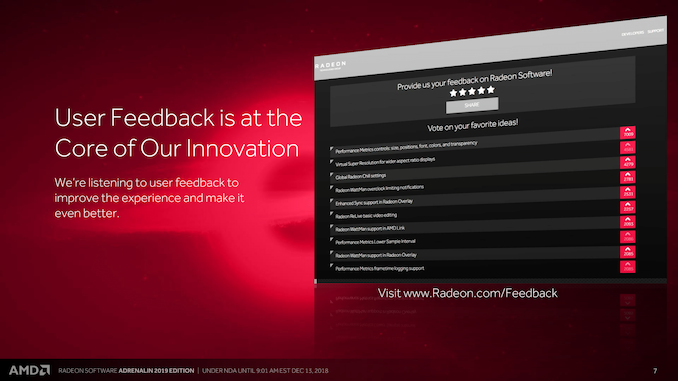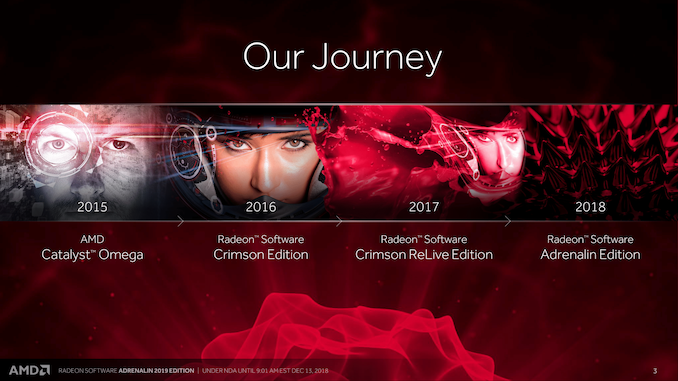AMD Releases Radeon Software Adrenalin 2019 Edition: Streaming for Videos, Games, & VR
by Nate Oh on December 13, 2018 9:01 AM EST
As 2018 winds down, once again it’s time for AMD’s annual major feature update for their graphics drivers, Radeon Software. Going by the unassuming title of ‘Radeon Software Adrenalin 2019 Edition’, today’s release is more of an evolution on last year’s Adrenalin Edition, bringing improvements and further integrations with AMD Link and Radeon Overlay. The headlining feature is the new capability to game stream to a mobile device or VR headset, powered by ReLive and AMD Link. AMD is also addressing highly-demanded user requests as collected on their feature voting and feedback page, now checkmarking 7 out of the top 10 requests.
Additionally, Adrenalin 2019 Edition 18.12.2 also brings WattMan overclocking/undervolting profile presets, WattMan controls in AMD Link and Radeon Overlay, ReLive improvements for streamers, and ‘Radeon Advisors’, the latter which are new game/settings optimization tools for entry-level users.
For those just catching up, AMD’s cadence of an annual ‘big bang’ driver update started back in 2014 with Catalyst Omega, following up with the introduction of Radeon Software in 2015 and its inaugural Crimson Edition, and subsequent yearly updates with Crimson ReLive Edition in 2016 and Adrenalin Edition in 2017.
This contemporary approach has hotfixes and performance updates occur throughout the year, punctuated by large feature updates and overhauls, with an overall emphasis on user experience (UX) and quality assurance.
The consistency of the UX is clearer with the latest discrete GPUs, but the same couldn't be said of AMD’s APU offerings. On that note, recent complaints on the status of outdated Ryzen Mobile drivers led AMD to release a statement on the matter. Adrenalin 2019 Edition doesn’t bring any changes on that front, and AMD has nothing to add to their original statement.
The new developments are however far from being irrelevant, as these annual feature updates, better zero-day game support, and cited stability metrics began as a move to stave off from the reputation of older AMD/ATI drivers. More directly, a consistent UX presumably also incorporates mobile APUs as well, especially since OEM vendors would have little interest in being involved in that aspect. A meaningful percentage of mainstream users will continue to have their experience with AMD drivers solely dictated by OEMs and without the ability to leverage AMD’s improvements in their driver development strategy.
Elsewhere, there’s no official updates on Radeon support for hardware-accelerated DirectX Raytracing, but with NVIDIA’s recent launch of Turing-based GeForce RTX series, it’s a topical theme.
Looking forward, there will be increased competition in the GPU space, and a lot of AMD’s incumbent advantages will be in software/driver maturity as well as feature support. With Adrenalin and now the Adrenalin 2019 Edition, there’s been a good deal of increased emphasis on streaming/social uses and mobile devices, and over the coming pages we’ll be taking a look at the specifics of each of the new features.












38 Comments
View All Comments
jordanclock - Thursday, December 13, 2018 - link
I'd be really interested to see if AMDs game stream app can be sideloaded to an Nvidia Shield TV. If it works, I would absolutely be in the market for an AMD card.Pablok - Thursday, December 13, 2018 - link
Exactly my thoughts.PhilipJ - Thursday, December 13, 2018 - link
I have to admit that the auto-overclocking & auto-undervolting features being exclusive to the RX Vega lineup of cards is a bit disappointingThough now I can at least stream video games to my phone lol
seamonkey79 - Thursday, December 13, 2018 - link
You're not missing anything. You can only use undervolt OR overclock GPU OR overclock RAM, no combination of the three. They seem to be present profiles, not doing any real testing except to see if the profile works or crashes.Using undervolt, I had no change in voltage.
Using GPU overclock I got 1%.
Using RAM I got 890.
Manually I'm able to far outdo any of those, and wonder of wonders, do all three at the same time.
It's at best a placebo to make some people think they have driver parity with Nvidia. I am sorely disappointed, though I'll admit my expectations were colored by the lack of them saying anything and seeing what Nvidia is capable of doing automatically.
sing_electric - Thursday, December 13, 2018 - link
AMD's previously said that they won't support DirectX Raytracing until they can offer it "in all product ranges." That means I wouldn't expect it in any cards that are on sale today, and possibly not with the first-gen Navi-based cards (the low end of which is rumored to be like a Vega 56). Of course, if the market changes - if RTX becomes essential to a lot of games in the next 2 years, or if Nvidia pulls a rabbit out of its hat and releases a RTX-capable GPU with say, Vega 56-like performance for $200 next year, then I'd bet AMD will do an about face very fast.https://wccftech.com/amds-david-wang-we-wont-imple...
haukionkannel - Thursday, December 13, 2018 - link
They actually did say that DirectX raytracing does not become mainstream until all product rages support it. There has been many not so well translated versions of that interview...But the head of AMD says the obvious that also low end products have to support raytracing until it will be popular...
BertrandsBox - Thursday, December 13, 2018 - link
Really disappointed that we're still not getting a solution for Ryzen Mobile.I bought a laptop with a 2500U in it and to say the driver situation is a mess would be the understatement of the century.
If really hoping they deliver on the promise of delivering more (or even manage a single) update through the OEMs or just deliver it themselves, because if not, they'll have lost a lot of fans on this.
StevoLincolnite - Thursday, December 13, 2018 - link
I have a Ryzen 2700U notebook and I have to agree.Thankfully Lenovo is a little bit ahead of other OEM's though in releasing updates...
evernessince - Thursday, December 13, 2018 - link
AMD can't force the OEM to update and the same goes for Nvidia. This is always a problem for laptops and completely depends on the vendor you buy from.Nothing AMD can do for each and every custom solution and it doesn't make sense for them to be doing other company's work.
limitedaccess - Thursday, December 13, 2018 - link
Nvidia and Intel both provide reference drivers on their website. As far as I know those will work without relying on OEM specific drivers.AMD does the same as well for mobility Radeon products as well as pre-Ryzen APUs mobile or desktop. Only mobile Ryzen APUs starting with Raven Ridge do not have drivers.
I wonder if there is some intrinsic hardware difference/issue that prevents this for mobile Ryzen APUs?